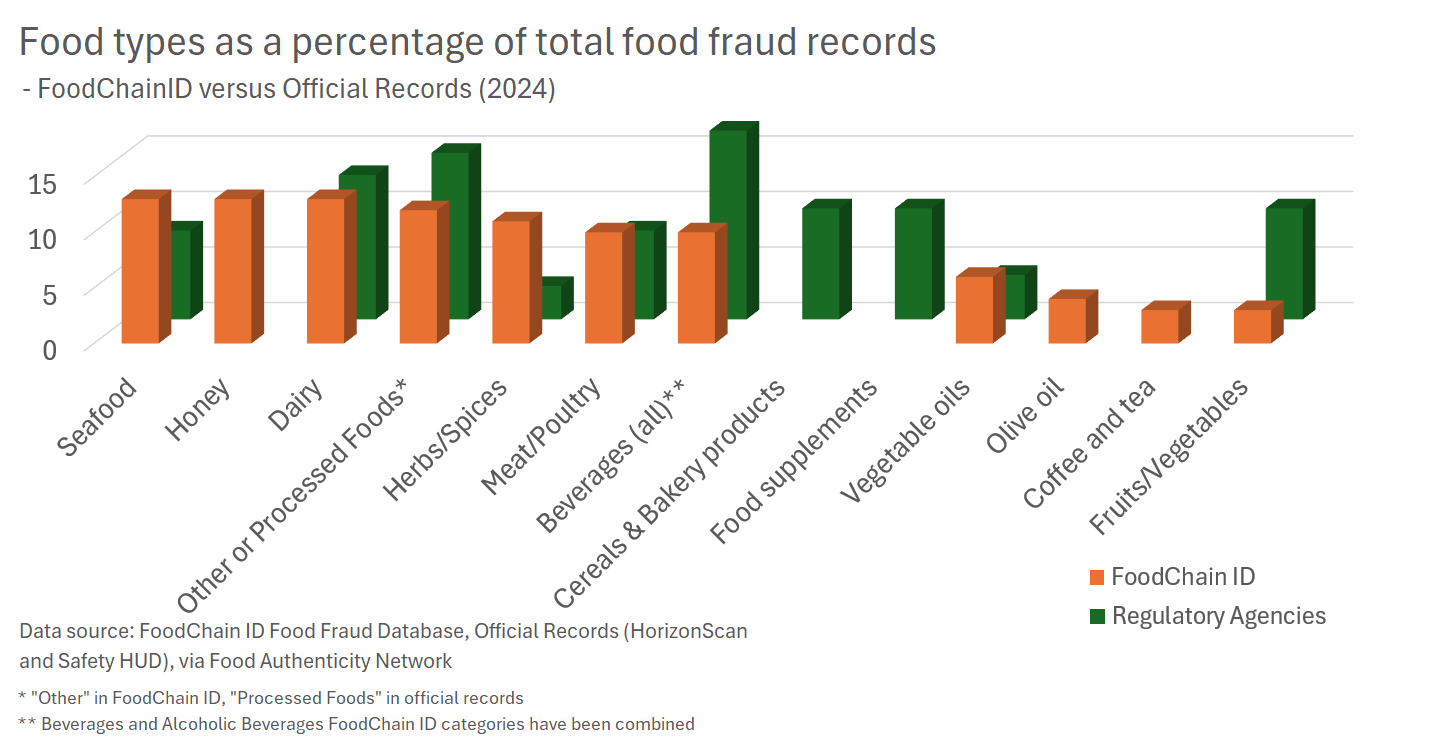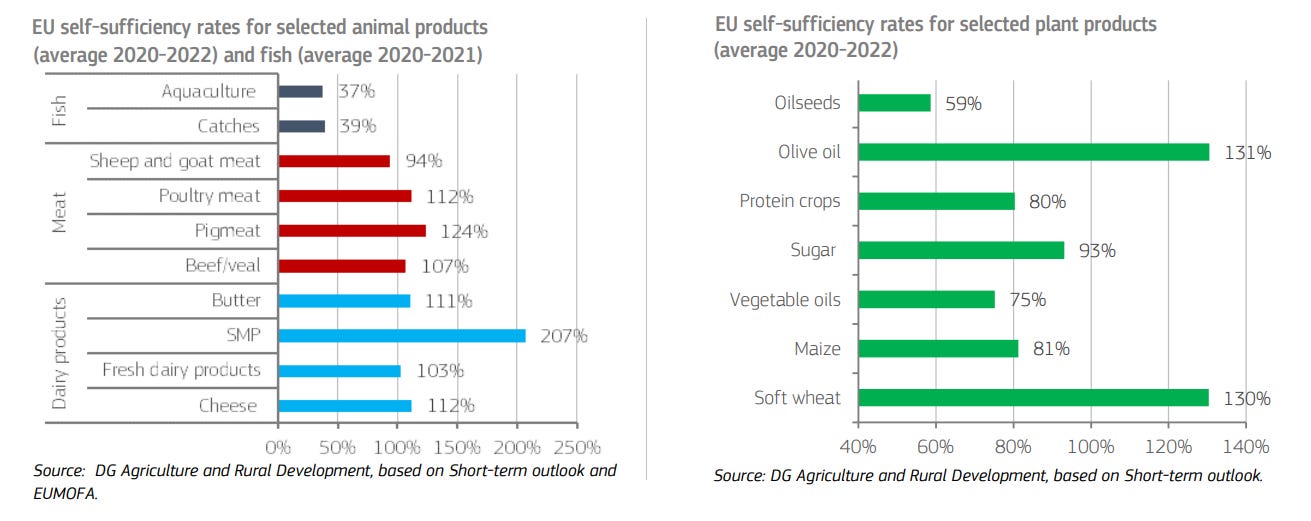This is The Rotten Apple, an inside view on food fraud and food safety for professionals, policy-makers and purveyors. Subscribe for insights, latest news and emerging trends straight to your inbox each Monday.
Global Food Fraud Trends (2024);
Follow up: Honey rules;
Animal Feed Safety Webinar 13th, 14th March;
Food Safety News and Resources;
Future food policy in Europe;
Food fraud news, emerging issues and recent incidents.
Hi, Welcome!
And an extra special welcome to our new paying subscribers from a food testing lab, a government agency, a flavour house and (!) the home of Swedish lasagna. Thank you 👏👏 Ali, David, Gerry, Lina and Sule 👏👏 Your financial support helps me do what I do every week.
This week I’m unpacking a new report on global food fraud trends. Do more reports mean more fraud, and why is the data (probably) skewed towards frauds with a safety impact?
Also this week, a high-level view of the future food policy for Europe, and a follow-up to last week’s honey story. And, as always, I’ve got food fraud news for paying subscribers and food safety news for everyone.
See you next week,
Karen
Animal Feed Safety Webinar Next Week
With a massive recall of eggs underway in Europe, caused by a problem with chicken feed, our upcoming training webinar feels very timely.
Join me and feed safety expert Bronwyn von Hellens to learn how feed safety is applied differently to human food safety and why safety incidents with feed can have such far-reaching consequences.
🍏🍏🍏 Put it in your diary: no reminder emails will be sent 🍏🍏🍏
Date and time: Thursday 13th March, 21:00 UTC (Los Angeles 2pm, London 9 pm, Johannesburg 11pm, Hong Kong 5 am Friday, Sydney 8 am Friday).
Follow-up: Honey Rules
Last week’s article about honey authenticity originated with a 2023 European operation known as ‘From the Hives’.
The results of the operation inspired new rules for non-European honey in Europe.
Under new rules, which began in December 2024, establishments exporting honey and other apiculture products to the EU must be listed on a register. The rules allow EU member states to target honey from certain establishments with intensified monitoring.
Establishments with infringements for honey adulteration or honey safety problems can be subject to additional controls which will only cease after a series of satisfactory results is achieved, with the honey importer responsible for the costs.
🍏 More information about the rules (via G. Marechal on LinkedIn) 🍏
Global Food Fraud Trends (2024)
Unpacking the Food Authenticity Network’s Global Food Fraud Report
Selvarani Elahi and her colleagues at the Food Authenticity Network have analysed the trends in food fraud incidents for 2024 and published a report, the second in their annual series.
I’m a huge food fraud nerd, as you know, but even I couldn’t get excited by the results. Don’t get me wrong, the report is great. But the trends? There just aren’t any. The data for 2024 is pretty much just more of the same.
Trends? What trends?
While this is the second year the Food Authenticity Network has been collating food fraud trends, I’ve been at it since 2015. So it’s no surprise to me that the report for 2024 looked almost exactly like the one for 2023.
The same types of foods are in the top ten, the same types of frauds feature at similar frequencies. The incident counts are quite stable across the year and between the years.

It’s good to know that the number of reported incidents is not increasing. Or is it? For me, the number of food fraud reports is more likely to be a reflection of the amount of attention being paid to food fraud, rather than the rate of occurrence.
The Food Authenticity Network report explores information from two separate data sets: ‘official’ reports, which are from regulatory agencies such as the United Kingdom’s Food Standards Agency, and commercial food fraud databases which include information from peer-reviewed scientific publications, news reports, and “other sources”.
Its authors note that official food fraud reports make up only a small fraction of all food regulatory reports - approximately 8 percent in 2024 - and say more regulatory agencies should share their food fraud data publicly.
Same resources, same results
If more agencies share their data, we might see an increase in the number of incidents recorded in next year’s report. Will this indicate a trend? No - at least not a trend in incidence - but it will reflect the higher number of records being shared by government agencies.
You see where I’m going with this… More enforcement activity and more testing by regulatory agencies will lead to more reported food fraud incidents. Not more food fraud incidents but more reports.
More focus, more records
Similarly, the food fraud types which are most likely to be included in the ‘official’ dataset are the ones that governments are most interested in. With limited resources, government agencies have to prioritise enforcement and investigation activities, which usually means prioritising food safety over food fraud and dangerous-to-health food fraud over other classes of food fraud.
The same applies to the commercial datasets, which draw their sources from regulatory agencies, peer-reviewed papers and international media. Researchers and media reporters are more likely to publish about frauds that have a potential impact on human health.
So it’s no surprise that the type of fraud I judge to be most common, misrepresentation of food without any adulteration or dilution, is not the most prevalent fraud type in the data.
Wrong species (animal and plant) accounts for the largest number of frauds in the data, at 38 percent, followed by the addition of non-food substances, dilution/substitution and artificial enhancement/unapproved biocides.
These four fraud types, plus unapproved colours, account for 81 percent of food fraud incidents in the 2024 data, with the remaining 19 percent being made up of labelling fraud, varietal misrepresentation, geographic origin fraud and “other fraud”.

Which foods are ‘worse’?
The same foods appear in the most-reported-food-fraud incidents every year, although there are differences between the regulatory reports and commercial databases.
Inconveniently, the two datasets use different categorisations, making it difficult to compare. For example, the commercial database does not include supplements but does include olive oil as a separate category, while official records are the opposite.
In the figure below, the official records are shown in green, with the commercial data in orange.

There’s better agreement within the same commercial database when comparing 2024 to the past 10 years (2015 to 2024). Within this database, the foods most likely to be the subject of a food fraud report have changed very little over time.
The top ten for 2024, according to FoodChain ID’s Food Fraud Database are:
Seafood
Honey
Dairy
Other
Herbs/Spices
Meat/Poultry
Alcoholic beverages
Vegetable oils
Olive oil
Coffee and tea
Honey ranked higher (more prevalent), at number 2 in 2024, compared to the ten-year average where honey is ranked sixth, but overall the foods and their rankings in 2024 are very similar to the ten-year average.

Takeaways for food professionals
The likelihood of food fraud in specific commodities may have changed over the past 12 months, but this is not necessarily reflected in the data, which only shows food fraud incidents that have been both discovered and publicly reported.
There are no significant trends or changes in the number or types of food fraud incidents compared to the previous year, although honey was the subject of more reports in 2024 compared to the ten-year average.
Food fraud occurs much more frequently than most people imagine. In 2016, the US Grocery Manufacturers’ Association estimated that 10 percent of all food is affected (source). Remain vigilant!
Main source:
Food Authenticity Network (2025) Global Food Fraud Report. Available at: https://documents.foodauthenticity.global/index.php/mnu-arts/fan-2024-global-food-fraud-report/viewdocument/129
Food Safety News and Resources
My food safety news and resources posts have no fluff, no filler, no ads, no promos, no junk, just expertly hand-curated food safety news from around the globe, brought to you each week. This week: massive recalls for eggs and guar gum, a PFAS-related fish recall (is this the first?), plus a long-running mystery outbreak is solved.
Click the preview below to read.
Quick update: future food policy in Europe
Following last week’s article about the changing regulatory landscape in the USA, here’s an update from the European Union, with thanks to Agnieszka de Sousa and Bloomberg Supply Lines (via email).
The European Union recently shared their new vision for agriculture and food.
The vision is an attempt to protect farmers and the agri-food sector from unfair competition from outside Europe, simplify regulations and protect consumers from imports by ensuring they meet the same safety standards as EU-grown products.
The European Union is the largest agri-food exporter in the world and has been increasing its trade surplus in recent decades. However, for fishery and aquaculture products, oilseeds and protein crops it is not self-sufficient, relying heavily on imports.

Takeaways for food professionals?
New regulations are planned for EU imports, with pesticide residue limits and animal welfare standards expected to tighten significantly as the European Commission seeks to align standards for imported foods with EU rules.
These regulations will affect businesses that export food to Europe, and importing businesses in Europe. Timeframes are unknown and enforcement could be years away.
Below for paying subscribers: Food fraud news, horizon scanning and incident reports
📌 Food Fraud News 📌
Dilution in botanicals
When you buy a natural supplement you expect to get at least enough active ingredient for the supplement to achieve its intended purpose. However, it’s common practice for suppliers to over-dilute the active ingredients in their botanical extracts, says the American Botanical Council (via SuppySide).
The challenge is that authenticity testing of botanical extracts often means testing for presence rather than potency.
Common diluents include





